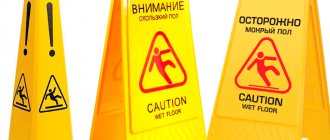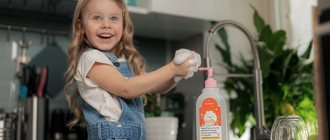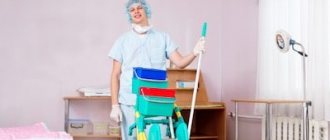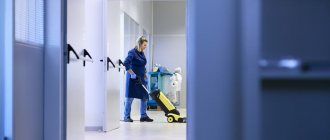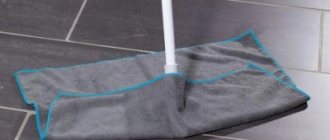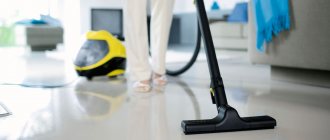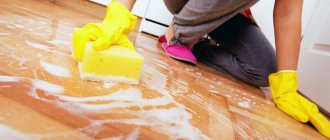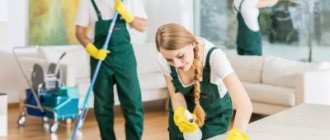Cleaning in medical organizations is necessary to prevent the spread of infectious disease pathogens through various surfaces. By touching a table or door handle, a person (patient or clinic staff) leaves bacteria or viruses there, and in return acquires new “passengers.” Thus, infectious agents quickly spread not only throughout the territory of the treatment and prevention organization, but also beyond its borders (public transport, pharmacies, shops, houses and apartments of patients and staff, etc.).
Due to the presence of an underlying disease, patients in clinics of various profiles are more vulnerable to infectious agents than healthy people. Therefore, cleaning in a medical organization is a special responsibility that falls on the shoulders of the staff.
The requirements for cleaning in medical organizations are set out in the sanitary and epidemiological rules SanPiN 2.1.3.2630-10 “Sanitary and epidemiological requirements for organizations engaged in medical activities” (hereinafter referred to as SanPiN 2.1.3.2630-10).
Types of cleaning in medical organizations
A division of cleaning into routine and general cleaning is provided.
Routine cleaning means wet cleaning of premises (cleaning floors, furniture, equipment, window sills, doors) at least 2 times a day using detergents and disinfectants approved for use in the prescribed manner (clause 11.1 of section 1 of SanPiN 2.1.3.2630-10 ).
General cleaning is also carried out using detergents and disinfectants. In this case, not only floors, furniture, equipment, window sills, doors are processed, but also walls, equipment and lamps. The frequency of general cleaning is once a week in rooms with an aseptic regime (operating unit, dressing rooms, delivery rooms, treatment rooms, manipulation rooms, sterilization rooms, etc.) and at least once a month in other rooms. In addition, outside the schedule, general cleaning is carried out when unsatisfactory results of microbial contamination of the external environment are obtained and for epidemiological indications.
Another difference between general cleaning and current cleaning is the mode of use of disinfectants. Thus, current cleaning is carried out according to regimes that ensure the death of bacterial microflora, and only in case of contamination of objects with blood and other biological substrates - according to an antiviral regime. When carrying out general cleaning, disinfectants with a wide spectrum of action are always used in modes that ensure the death of bacteria, viruses and fungi. The exceptions are ward departments, doctors' offices, administrative and utility rooms, departments and rooms of physiotherapy and functional diagnostics, where even during general cleaning, disinfectants are used according to regimes that ensure the death of bacterial microflora.
Means and tools
The quality of hospital disinfection largely depends on the proper selection of equipment and cleaning products. Within a medical institution, you can encounter not only the presence of ordinary dirt and household dust, but also bacteria, viruses, and other pathogenic microorganisms that can become sources of various infections.
Bucketless cleaning in a medical institution, in which a nurse simply wipes horizontal surfaces with a damp cloth, is unacceptable. It is imperative to use professional equipment and products with powerful bactericidal and antifungal effects. The administration of the institution must provide the employee with full equipment. It includes:
- a set of protective clothing (robe, rubber shoes, cap, gloves, respirator, goggles);
- containers in which concentrates will be diluted, buckets for clean water;
- mop, battery brushes, rags and rags;
- disinfectant solutions;
- detergents.
Each item has its own marking. The equipment is sterilized before use. It is stored in a specially designated place. It is used only in those premises for which it was originally intended. The mop used to clean the floors in the toilet will never be used to clean the floors in the rooms where patients are lying.
Effective cleaning of premises of medical organizations
What needs to be done to ensure that cleaning the premises of medical organizations is effective?
Firstly, ensure the integrity of the hygienic coating of the surfaces being treated. That is, the surfaces of walls, floors, ceilings, furniture, equipment, heating devices, etc. should not have chips, crevices, cracks, other mechanical damage, signs of corrosion, etc. Their surface must be smooth, preventing the adsorption of dust (clause 4.2 of section 1 of SanPiN 2.1.3.2630-10).
Secondly, the covering of floors, walls, ceilings, furniture, equipment, heating devices, etc. must be made of materials that are resistant to treatment with detergents and disinfectants (clause 4.2 of section 1 of SanPiN 2.1.3.2630-10).
Thirdly, it is necessary to place furniture and equipment in the premises in such a way that all surfaces are easily accessible during cleaning (clauses 6.2 and 8.2 of section 1 of SanPiN 2.1.3.2630-10).
Fourthly, choose the right detergents and disinfectants, ensure their proper storage and preparation of working solutions (clauses 11.1–11.4 of section 1 of SanPiN 2.1.3.2630-10).
Fifthly, allocate a sufficient amount of cleaning equipment, ensure its marking and storage (clauses 11.5, 11.11 of section 1 of SanPiN 2.1.3.2630-10).
Sixth, train personnel in the technique and frequency of routine and general cleaning (clause 11.1 of section 1 of SanPiN 2.1.3.2630-10).
Wash compositions
The entire complete list of disinfectants for cleaning is contained in the approved Sanpin standards. Here are just a few of them:
- bleach;
- chloramine;
- peroxide;
- compositions with surfactants.
According to the instructions supplied with each product, it is necessary to dilute the detergent in water. Also, the concentration of the solution depends on the type of room where the cleaning will be done. Work with solutions must be carried out in special clothing. Be sure to avoid applying chemical solutions to your skin and face.
In hospitals and clinics, cleaning the premises is of a special nature. With unsanitary conditions, viruses and various infections quickly develop. This situation should absolutely not be allowed to happen.
Employees of medical institutions who perform routine or general cleaning must have special education. Employees are required to familiarize themselves with the specifics of the organization’s activities. Most of the products used are not publicly available; they can only be purchased in specialized stores.
Cleaning in hospitals is significantly different from cleaning at home. Specialists working in healthcare institutions have a document on knowledge in the field of sanitation.
Certificates are issued after training. Also, specialists in sanitation rules must undergo regular courses to improve their skills.
Handling and storage of cleaning equipment
Maintenance of cleaning equipment is an integral part of the cleaning process and includes washing and disinfection, as well as proper storage of clean equipment. Poorly treated rags, cleaning containers and mops accumulate microorganisms and themselves become factors in the transmission of infection.
Sanitary rules SanPiN 2.1.3.2630-10 (clause 11.5 of section 1) provide for the possibility of processing mops and rags in washing machines specially designated for these purposes, which are installed in places where cleaning carts are assembled.
A separate room must be allocated for storing cleaning equipment (clause 11.5 of section 1 of SanPiN 2.1.3.2630-10), equipped with racks or other devices for fixed storage of mops, containers and rags.
Thus, the cleaning process is one of the key links in the prevention of nosocomial infection. Despite the ordinary nature of the cleaning process, medical organizations face significant difficulties in organizing it. Solving these problems is possible with an integrated approach and the development of step-by-step algorithms and visual instructions for personnel performing cleaning and maintaining cleaning equipment in each specific medical organization.
What types are there?
There are a number of methods of general and routine cleaning used in clinics and hospitals. Namely:
- Physical. Boiling method, ultraviolet irradiation, steam disinfection.
- Mechanical. Cleaning with damp cloths, daily and regular hand washing by medical personnel.
- Chemical. By soaking in a disinfecting solution and completely immersing the required item.
There is also a combined one. Several methods can be used simultaneously or several methods can be used interleaved.
Algorithm for carrying out a wet cleaning procedure
Use of personal protective equipment in wards
The beginning of cleaning should be accompanied by the removal, if possible, of all patients to another ward or corridor for rest. Next, the nurse responsible for putting things in order puts on personal protective equipment and opens the windows for ventilation. She puts on overalls with personal protective equipment, namely a robe with a cap, mask, rubber gloves and an apron. Wearing protective clothing is important due to the use of compounds used to treat the premises, which can begin to burn the skin and lead to irritation and other consequences.
Cleaning is done only with a wet method. It is done after breakfast. Patients who are unable to leave the premises are covered during all procedures. The second time is done before bedtime. The treatment of the room begins with the bedside tables, window sill and furniture placed in the room. Then the walls and floor are washed. Rubbish collects in the corridor. Washing is done with bleach or chloramine. In the infectious diseases department, the wards are thoroughly cleaned every 10 days. The bucket with the rag is labeled and used strictly in accordance with the labeling. When a patient who is allergic to chlorine is in the room, the room is washed with soap and soda solution.
The cafeteria and pantry sections are sanitized after each time food is served. It is then disinfected twice with chloramine. Tables are wiped down four times an hour with a chloramine solution. Used dishes are soaked in it for an hour, then washed with soap and boiled in a soda solution.
Note! All equipment with rags must be disinfected in chloramine and lime. Then it is washed and dried. It is imperative that after washing and processing the equipment, it is marked. The processing time is specified and the possibility of reuse is indicated. Naturally, it is placed in a special place that is inaccessible to the eyes and hands of patients. Lockable with a key.
In general, wet cleaning is a mandatory disinfection and disinfection procedure, the algorithm for which is recorded in the Sanpin regulations, rules and instructions of the clinic. It is performed at a strictly fixed time using special solutions. The time of the procedure is indicated in a special journal.
Main stages of cleaning
General cleaning in medical institutions consists of two stages:
- Sanitary and hygienic.
- Disinfection.
The first stage includes washing surfaces and deep cleaning them. Damage repair, restoration of protective coatings.
The procedure for carrying out general cleaning in medical institutions at the second stage is as follows:
- Disinfection of surfaces.
- Disinfection of equipment.
- Air disinfection.
The fourth and fifth stages of cleaning
After the disinfection time has passed, you must:
- Wear clean clothes, mask, cap, gloves.
- Wash your hands, sanitize your shoes.
- Rinse the containers that contained the disinfectant solution with clean water.
- Pour tap water and wash all surfaces that were treated in the same sequence as the solution was applied.
- Wipe windows and surfaces dry with a clean, dry rag, if required by the instructions for using the disinfectant solution.
- In sterile blocks, sterile rags are used for processing.
- Finally, wash the floors with tap water. Use clean rags. The bucket must be labeled.
- Take off clothes, mask, cap, gloves.
- Give clothes to be washed.
- Dispose of gloves, cap and mask.
- To wash hands.
Then proceed to the final stage:
- Turn on the bactericidal lamp.
- The log records the time of quartzing the room and carrying out general cleaning.
After the required time has passed, the room is ventilated for 15-20 minutes, depending on the weather.
For the final stage of general cleaning in a medical facility, the procedure is as follows:
1. After cleaning is completed, it is necessary to disinfect the equipment that was used. Carry out disinfection:
- Rags.
- Floor cloth.
- Inventory.
2. After disinfection, rinse everything in clean water and dry. The rags are sent for washing.
3. Before the onset of the cold season, cleaning includes washing windows on both sides and tightly closing the frames.
Nutrition in medical institutions
The new SanPiN 2.3/2.43590-20 in Appendices No. 1-No. 13 reflects the nutrition requirements in catering facilities of medical institutions. With regard to the organization of catering in hospitals in 2022, new restrictions have been significantly reduced. The regulation no longer requires compliance with the rules for preparing pasta; there is no list of products prohibited in the hospital, but there are general requirements:
- the sanitary doctor is obliged to take a daily sample of food in a separate container, disinfected and tightly closed;
- record the results of sampling in rejection logs;
- if there is no hot food in the day hospital, there should be a separate room where food will be heated, a refrigerator and a washbasin should be installed here;
- Prepared food must be transported in special containers approved for this purpose.
The organization of meals for patients of medical institutions is in section VII of SanPiN. The document recommends compliance with the following requirements:
- develop a varied diet;
- food is issued only after a daily sample has been taken and collected by the responsible person;
- A list of permitted products must be posted at the delivery location.
IMPORTANT It
is not allowed to leave leftover food in the dining room; after feeding patients, everything is carefully cleaned.
Who is allowed to clean?
Cleaning should be carried out by medical personnel:
- Nurses.
- Specially trained nurses.
To carry out general cleaning in a medical facility, the requirements for cleaners are as follows:
- At least 18 years of age.
- It is necessary to undergo special training on working with disinfectant solutions.
- Know the instructions for your functional responsibilities.
- Pass a medical examination.
- People with hypersensitivity to chemical solutions are not allowed to clean.
- Personnel must know how to provide assistance in case of poisoning with a disinfectant solution.
There are instructions for general cleaning in a medical facility. It must be examined by the medical personnel who will perform the cleaning.
Ventilation requirements
According to SP 2.1.3678-20, when operating ventilation systems, they should not intersect. Whether there is forced ventilation or not, treatment and diagnostic rooms should have vents on the windows for natural ventilation. If the building design does not allow the installation of transoms, shutters, supply and exhaust ventilation is installed so that it is capable of supplying outside air in sufficient volume, and the cleanliness of the air throughout the hospital complies with hygienic standards.
IMPORTANT
When air is supplied by the air supply unit, it is cleaned with filters. The exchange of air spaces between wards of medical institutions should not flow. It is mandatory to organize a gateway to prevent the penetration of air masses between the ward section, the operating unit, resuscitation and intensive care. The flow of air according to SanPiN in 2022 is blocked in the ventilation system between the wards and toilets. Supply ventilation systems are installed in separate rooms. Exhaust ventilation is carried out from showers, toilets, warehouses with dirty linen.
Nuances
The requirements of SanPiN, even in an abbreviated version, are so extensive, and medical staff from every level at any position must comply with every point so that administrative liability does not arise. All employees are trained and instructed on how to act in various unforeseen situations. If biological materials are splashed during medical procedures, the immediate supervisor is notified and the necessary disinfection measures are taken. The offices of medical workers must be equipped with first aid kits, dressings, a solution of protargol, potassium permanganate, and iodine.
Laundry
The collection, sorting and transportation of dirty linen is carried out by technical employees; people who treat and care for patients - doctors, nurses - are not allowed to participate in this process. Employees who change linen must be provided with special clothing, which, together with sheets and duvet covers, is sent for washing. The mask and gloves are treated with disinfectants and antiseptics. They collect dirty linen in the wards in thick bags. After changing the sheets and pillowcases, the room is cleaned. Linen with traces of blood and biological secretions is disinfected immediately in the pantry, the rest of the items are sorted and packaged. According to SanPiN of medical institutions, in 2022, packages are transported on a cart to the hospital laundry. Where is washing done in washing machines?
Wet cleaning schedule
Healthcare units should have written cleaning schedules.
How often wet cleaning of wards should be carried out is prescribed in the SanPiN regulations. It is usually carried out at least twice a day. If necessary or under special conditions - more often.
Cleaning and quartzing schedules for each area are planned, written, signed, approved and posted. They indicate the time and object of cleaning, the name of the orderly or nurse. Where one or the other puts his painting at the end of the work.
Preparatory activities
In order to begin general cleaning, you need to prepare the room. Namely:
- Clear cabinets of medications.
- Clear shelves and tables for processing.
- Remove food items.
- Defrost the refrigerator.
- Move furniture away from the walls.
- Take out the trash.
- Dispose of disposable medical device waste.
- Remove equipment and tools from the office.
- Turn off electrical appliances.
After the room has been prepared for cleaning, disinfectant and cleaning solutions are prepared.
